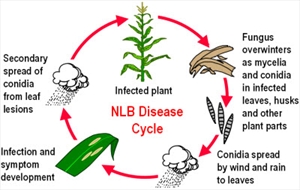Maize leaf blight, maize northern leaf blight
Pacific Pests, Pathogens and Weeds - Online edition
Pacific Pests, Pathogens & Weeds
Maize northern leaf blight (226)
Setosphaeria turcica; the asexual stage name is Exserohilum turcicum. It has also been known as Helminthosporium turcicum. There are many races or strains of the fungus.
Asia, Africa, North, South and Central America, the Caribbean, Europe, Oceania. It is recorded from Australia, Fiji, French Polynesia, New Caledonia, New Zealand, Papua New Guinea, Tonga, and Wallis & Futuna.
Maize, sorghum, and wild grasses (Echinochloa, Panicum, Pennisetum, and more).
Large, usually oval, grey or light brown leaf spots, sometimes with dark margins, 25-150 mm long (Photos 1&2). The spots merge covering large parts of the leaves. Symptoms occur first on the lower leaves, except when plants become infected by large numbers of spores from the atmosphere. In moist weather, brown fungal growth containing spores occurs on the spots, often in concentric zones. The disease causes the leaves to dry out, wither and die.
Spread occurs as spores carried in rain splash and air currents to new plantings (Diagram). Large storms can carry the spores over long distances. Survival is on plant remains - leaves, husks, and other plant parts - as fungal growth and spores. Thick walled spores ('chlamydospores') are produced, allowing survival of the fungus for up to 2 years. Survival also occurs on 'volunteer' plants. There is no evidence that it is seedborne, although it is in sorghum.
Heavy dews, frequent light showers, high humidity and moderate temperatures favour the disease. Water covering the leaves for 6-18 hours, and temperatures in a range of 18-27°C, are needed for spore germination and infection.
An important disease causing loss of grain and also animal fodder, but one that can be controlled by growing resistant varieties. If not controlled, spots occur on the ear leaf and above and there is significant loss of green leaf area, and consequently loss of yield.
Look for the long grey tapering leaf spots, more than 100 mm long. Look to see the black fungal mould on the spots.
Look to see differences between maize northern leaf blight and southern leaf blight (Cochliobolus heterostrophus). Spots caused by maize northern leaf blight are larger, and fewer than spots caused by southern leaf blight, and they are mostly on the leaves (see Fact Sheet no. 80).
CULTURAL CONTROL
Before planting:
- Choose hybrid varieties with known resistance to maize northern leaf blight; this is the most important way of managing the disease.
During growth:
- Make sure that the plants have adequate nutrients. Do not over supply nitrogen, but make sure phosphorus and potassium are at optimal levels.
- Control weeds, especially grasses that might be alternative hosts of the fungus.
After harvest:
- Collect the remains of the crop and destroy by burning or burying.
- Practise crop rotation; rotate with non-grass crops.
RESISTANT VARIETIES
There are resistant hybrid varieties to this disease; check those available from retailers in your country.
CHEMICAL CONTROL
Chemical control should not be necessary for the management of this disease, and its use is unlikely to bring economic returns. However, if fungicides are needed, use chlorothalonil or mancozeb.
____________________
When using a pesticide, always wear protective clothing and follow the instructions on the product label, such as dosage, timing of application, and pre-harvest interval. Recommendations will vary with the crop and system of cultivation. Expert advice on the most appropriate pesticide to use should always be sought from local agricultural authorities.
AUTHOR Grahame Jackson
Information from CABI (2012) Setosphaeria turcica (maize leaf blight). Crop Protection Compendium. (https://www.cabi.org/cpc/datasheet/49783). Photos 1&2 Kohler F, et al. (1997) Diseases of cultivated crops in Pacific Island countries. South Pacific Commission. Pirie Printers Pty Limited, Canberra, Australia. and Setosphaeria turcica. Wikipedia. (https://en.wikipedia.org/wiki/Setosphaeria_turcica); and Diagram (and information) Svec L, Dolezal B (undated) Crop insights: managing northern corm leaf blight race shifts. Pioneer. (https://www.pioneer.com/us/agronomy/Managing-Northern-Corn-Leaf-Blight.html/).
Produced with support from the Australian Centre for International Agricultural Research under project PC/2010/090: Strengthening integrated crop management research in the Pacific Islands in support of sustainable intensification of high-value crop production, implemented by the University of Queensland and the Secretariat of the Pacific Community.






